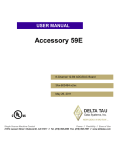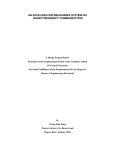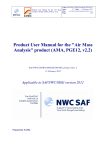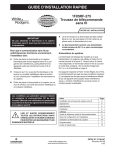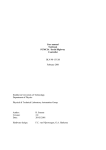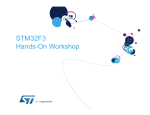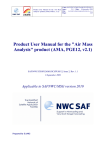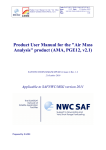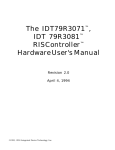Download Windows 95/98 Device Driver for PCMCIA Notebook
Transcript
Windows 95/98 Device Driver
for PCMCIA Notebook/Serial Highway
Controller
BLN 2001-08 UM
March 2001
Eindhoven University of Technology
Department of Physics
Physical & Technical Laboratory Automation Group
Author:
Version:
Date:
R. Smeets
1.0
16-03-2001
Table of contents
1.
Introduction . . . . . . . . . . . . . . . . . . . . . . . . . . . . . . . . . . . . . . . . . . . . . . . . . . . . . . . . 3
1.1 General . . . . . . . . . . . . . . . . . . . . . . . . . . . . . . . . . . . . . . . . . . . . . . . . . . . . . . . 3
1.2 Conventions used in this manual . . . . . . . . . . . . . . . . . . . . . . . . . . . . . . . . . . . 4
2.
Driver interface overview . . . . . . . . . . . . . . . . . . . . . . . . . . . . . . . . . . . . . . . . . . . . . 5
2.1 Description of functional groups . . . . . . . . . . . . . . . . . . . . . . . . . . . . . . . . . . . 5
2.2 Device driver error codes . . . . . . . . . . . . . . . . . . . . . . . . . . . . . . . . . . . . . . . . . 6
3.
Driver initialization and finalization functions . . . . . . . . . . . . . . . . . . . . . . . . . . . . . 7
4.
PhyBUS I/O and PhyBUS control functions . . . . . . . . . . . . . . . . . . . . . . . . . . . . . . 11
5.
Exception handling . . . . . . . . . . . . . . . . . . . . . . . . . . . . . . . . . . . . . . . . . . . . . . . . . 19
5.1 Description of exceptions . . . . . . . . . . . . . . . . . . . . . . . . . . . . . . . . . . . . . . . . 19
5.2 Exception functions . . . . . . . . . . . . . . . . . . . . . . . . . . . . . . . . . . . . . . . . . . . . 22
6.
Miscellaneous functions . . . . . . . . . . . . . . . . . . . . . . . . . . . . . . . . . . . . . . . . . . . . . 25
1
2
1.
Introduction
1.1
General
This document describes the functions and the Application Programming Interface
(API) of the Virtual Device Driver (VxD) for the Notebook/Serial Highway Controller (BLN
98-15) for Windows 95/98.
The driver offers a C interface to an application program.
The device driver, including the installation script, consists of the following files:
!
NHC9815.VXD: this file contains the actual device driver for the PCMCIA
card in the notebook
!
NHCIO.DLL: this file interfaces the device driver to an application program.
!
9815.RBF, 9815B.RBF: these files contain the configuration for the
programmable logic devices on the PCMCIA card.
!
HIGHWAY.INF: this file contains the Windows 95/98 installation script for
installing the PCMCIA card in a notebook or laptop computer
The files NHC9815.VXD, NHCIO.DLL, 9815.RBF and 9815B.RBF are installed in the
\WINDOWS\SYSTEM directory.
An application program must include and link the following source files to obtain the
entry points of the PhyBUS functions:
!
NHC.H
!
NHCLIB.C
A number of functions return the hardware status of the Notebook/Highway
Controller or can modify its settings. See the user manual of the Notebook/Highway
Controller for specific information (BLN 98-15 UM).
3
1.2
Conventions used in this manual
As the interface to the driver is intended to be used in a C programming environment
with the Windows 95/98 operating system, the conventions used in this manual (with respect
to types, include files, etc.) are Windows/C-like.
An application must always #include <windows.h> !
A short description of the types used by the driver:
WORD
word, 16 bits
DWORD
double word, 32 bits
VOID
if defined as a formal function parameter: function needs no actual
parameter
if defined as a function return value: function does not return a value
PWORD
pointer to a word
PDWORD
pointer to a double word
PVOID
if defined as a formal function parameter: actual parameter can be a
pointer to any type
if defined as a function return value: the return value can be a pointer to
any type
4
2.
Driver interface overview
2.1
Description of functional groups
The driver functions are divided into the following functional groups:
1.
2.
3.
4.
driver initialization and finalization functions.
PhyBUS I/O and PhyBUS control functions
PhyBUS exception functions (interrupts & bus errors )
miscellaneous
All driver functions start with the prefix “pb”. Every function returns a DWORD,
indicating function success or failure: if the function return value is 0 (zero, PB_OK), the
function was successful. A non-zero return value indicates failure. In this case, the error value
identifies the specific failure. See section 2.2.
5
2.2
Device driver error codes
The error codes are defined in the file “nhc.h” and are given in table 2.1. Do not use
literal error code values for processing errors, but use the symbolic names (table 2.1).
A number of error codes specify internal driver errors, and serve only as a means for
tracking down internal system errors.
PB_OK
PB_ERR_NOT_OPEN
PB_ERR_NO_IOPORT_EPLD
PB_ERR_NO_IOPORT_PB
PB_ERR_RBF_OPEN
PB_ERR_RBF_READ
PB_ERR_RBF_CLOSE
PB_ERR_EPLD_CONFIG
PB_ERR_EPLD_RESET
PB_ERR_CFG_NO_DEVNODE
PB_ERR_CFG_BAD_DEVCONFIG
PB_ERR_CFG_BAD_IO
PB_ERR_CFG_BAD_ATTMEM
PB_ERR_CFG_BAD_IRQ
PB_ERR_INVALID_ADDRESS
PB_ERR_PROTOCOL_SLAVE
PB_ERR_PROTOCOL_MASTER
PB_ERR_BUSERROR_READ
PB_ERR_BUSERROR_WRITE
PB_ERR_BUSERROR_INIT
PB_ERR_BAD_LINK
PB_ERR_MALLOC
PB_ERR_OPENKEY
PB_ERR_CLOSEKEY
PB_ERR_QUERYKEY
PB_ERR_ALLOCKEY
PB_ERR_VXDFAILURE
PB_ERR_NOVXD
PB_ERR_UNLOAD
PB_ERR_CLOSEHANDLE
PB_ERR_THREADPRIORITY
PB_ERR_PROCESSPRIORITY
PB_ERR_NOTHREAD
Table 2.1
OK, no error
PhyBUS not open
no IO port available for loading EPLD
no IO port available for PhyBUS access
error opening RBF file
error reading RBF file
error closing RBF file
EPLD configuration error
EPLD reset error
error in locating device node
error in reading node configuration
error in IO config
error in attribute memory config
error in IRQ config
invalid PhyBUS address
protocol error slave side
protocol error master side
PhyBUS read bus error
PhyBUS write bus error
initPB bus error
data errors testing Highway link
general memory alloc error
error opening registry key
error closing registry key
error query key
error memory alloc for key
driver failed
NHC9815 VxD not found
VxD unload error
close handle failed
error setting exception thread priority
error setting current process priority
no exception thread running
Device driver error codes
6
3.
Driver initialization and finalization functions
The following functions are used to initialize the driver and the interface to the
driver. These functions must be called before using any PhyBUS function. Functions for
finalizing the driver are also described.
Driver initialization and finalization functions should be used in the order as given in
the following sample code:
DWORD result;
result = pbInitPhyBUSDLLEntries();
if (result != PB_OK) { /* error */
exit(1);
}
result = pbLoadVxD();
result = pbOpen();
/* run your application here */
result = pbClose();
result = pbUnloadVxD();
7
pbClose
Synopsis:
#include “nhc.h”
DWORD pbClose(VOID);
Description: This function performs the (hardware) finalization of the Notebook/Serial
Highway Controller and disables the controller for subsequent PhyBUS
operations. Internal data structures are finalized, and internal system resources
are freed.
Returns:
The function returns PB_OK if finalization has succeeded. A non-zero return
value indicates a failure.
See also:
pbOpen
Example:
-
pbInitPhyBUSDLLEntries
Synopsis:
#include “nhc.h”
DWORD pbInitPhyBUSDLLEntries(VOID);
Description: This function initializes the driver entry points (addresses) of the PhyBUS
functions in the file NHCLIB.C. This function must be called before calling
any other driver function!
Returns:
the function returns PB_OK if all driver entry points are initialized correctly. A
non-zero return value specifies the number of non-initialized entries. An
application program should not continue if the function returns non-zero!
See also:
-
Example:
result = pbInitPhyBUSDLLEntries();
if (result != PB_OK) { /* error */
exit(1);
}
8
pbLoadVxD
Synopsis:
#include “nhc.h”
DWORD pbLoadVxD(VOID);
Description: This function loads the Virtual Device Driver (VxD).
Returns:
The function returns PB_OK if the driver is loaded succesfully. A non-zero
return value indicates a load failure (e.g. the file NHC9815.VXD is not located
in the \WINDOWS\SYSTEM directory).
See also:
pbUnloadVxD
Example:
-
pbOpen
Synopsis:
#include “nhc.h”
DWORD pbOpen(VOID);
Description: This function performs the hardware initialization of the Notebook/Serial
Highway Controller and enables the converter for subsequent PhyBUS
operations. Internal data structures are initialized. I/O resources and system
resources for handling interrupts are assigned.
If a PhyBUS crate with auto-configuration capabilities is used, this
function also determines the current PhyBUS configuration. See section 4 for a
description.
Returns:
The function returns PB_OK if the Notebook/Serial Highway Controller is
succesfully initialized. A non-zero return value indicates a failure.
See also:
pbClose
Example:
-
9
pbUnloadVxD
Synopsis:
#include “nhc.h”
DWORD pbUnloadVxD(VOID);
Description: This function unloads the Virtual Device Driver, thereby freeing system
resources. The driver can be unloaded by the application if the application
program terminates, or if the driver is not needed anymore. If the application
exits without calling pbUnloadVxD, the unloading is performed by the
operating system.
Returns:
The function returns PB_OK if the driver is unloaded succesfully. A non-zero
return value indicates an unload failure.
See also:
pbLoadVxD
Example:
-
10
4.
PhyBUS I/O and PhyBUS control functions
The PhyBUS I/O and PhyBUS control functions perform word or double word I/O
operations on PhyBUS addresses.
Executing a read or a write access on a non-accessible PhyBUS address results in a
bus error. As a default, a read bus error is signaled by the the return value
PB_ERR_BUSERROR_READ of the invoked function, a write bus error is signaled by the
return value PB_ERR_BUSERROR_WRITE of the invoked function. See section 6 for
handling of PhyBUS bus errors.
pbClearBitsLong
Synopsis:
#include “nhc.h”
DWORD pbClearBitsLong(WORD Address, DWORD Mask);
Description: This function clears the bits, specified in the doubleword Mask, at PhyBUS
address Address. All other bits remain unchanged. The PhyBUS address must
be a valid PhyBUS address in the range 0..4095 and the address must be even!
Returns:
The function returns PB_OK if it has succeeded. A non-zero return value
indicates a failure.
See also:
pbClearBitsWord, pbSetBitsWord, pbClearBitsLong, pbSetBitsLong
Example:
/* clear bits 2..0 at PhyBUS address 0x100 */
result = pbClearBitsLong(0x100, 0x7);
/* clear bit 31 at PhyBUS address 0x100 */
result = pbClearBitsLong(0x100, 0x80000000);
11
pbClearBitsWord
Synopsis:
#include “nhc.h”
DWORD pbClearBitsWord(WORD Address, WORD Mask);
Description: This function clears the bits, specified in the word Mask, at PhyBUS address
Address. All other bits remain unchanged. The PhyBUS address must be a
valid PhyBUS address in the range 0..4095.
Returns:
The function returns PB_OK if it has succeeded. A non-zero return value
indicates a failure.
See also:
pbSetBitsWord, pbClearBitsLong, pbSetBitsLong
Example:
/* clear bits 2..0 at PhyBUS address 0x37 */
result = pbClearBitsWord(0x37, 0x7);
/* clear bit 15 at PhyBUS address 0x37 */
result = pbClearBitsWord(0x37, 0x8000);
12
pbGetLong
Synopsis:
#include “pb.h”
DWORD pbGetLong(WORD Address, PDWORD pData);
Description: This function reads a double word from the PhyBUS address Address. The
double word read is stored in the location pointed to by pData. The PhyBUS
address must be a valid PhyBUS address in the range 0..4095 and the address
must be even!
Returns:
The function returns PB_OK if it has succeeded. A non-zero return value
indicates a failure.
See also:
pbGetWord, pbPutWord, pbPutLong
Example:
DWORD dataread;
/* receives result of pbGetLong */
/* read double word from PhyBUS address 0x012, and store it in
dataread */
result = pbGetLong(0x012, &dataread);
13
pbGetWord
Synopsis:
#include “nhc.h”
DWORD pbGetWord(WORD Address, PWORD pData);
Description: This function reads a word from the PhyBUS address Address. The word read
is stored in the location pointed to by pData. The PhyBUS address must be a
valid PhyBUS address in the range 0..4095.
Returns:
The function returns PB_OK if it has succeeded. A non-zero return value
indicates a failure.
See also:
pbGetWord, pbPutWord, pbGetLong, pbPutLong
Example:
WORD dataread;
/* receives result of pbGetWord */
/* read word from PhyBUS address 0x013, and store it in dataread */
result = pbGetWord(0x013, &dataread);
pbInit
Synopsis:
#include “nhc.h”
DWORD pbInit(VOID);
Description: This function executes a global reset of ALL PhyBUS interfaces.
Returns:
The function returns PB_OK if it has succeeded. A non-zero return value
indicates a failure.
See also:
-
Example:
-
14
pbPutLong
Synopsis:
#include “nhc.h”
DWORD pbPutLong(WORD Address, DWORD Data);
Description: This function writes the double word Data to the PhyBUS address Address.
The PhyBUS address must be a valid PhyBUS address in the range 0..4094,
AND the address must be even!
Returns:
The function returns PB_OK if it has succeeded. A non-zero return value
indicates a failure.
See also:
pbGetWord, pbPutWord, pbGetLong
Example:
/* write double word to PhyBUS address 0x12 */
result = pbPutLong(0x012, 0x12345678);
pbPutWord
Synopsis:
#include “nhc.h”
DWORD pbPutWord(WORD Address, WORD Data);
Description: This function writes the word Data to the PhyBUS address Address. The
PhyBUS address must be a valid PhyBUS address in the range 0..4095.
Returns:
The function returns PB_OK if it has succeeded. A non-zero return value
indicates a failure.
See also:
-
Example:
/* write word to PhyBUS address 0x11 */
result = pbPutWord(0x011, 0x5678);
15
pbSetBitsLong
Synopsis:
#include “nhc.h”
DWORD pbSetBitsLong(WORD Address, DWORD Mask);
Description: This function sets the bits, specified in the double word Mask, at PhyBUS
address Address. All other bits remain unchanged. The PhyBUS address must
be a valid PhyBUS address in the range 0..4094, AND the address must be
even!
Returns:
The function returns PB_OK if it has succeeded. A non-zero return value
indicates a failure.
See also:
pbSetBitsWord, pbClearBitsWord, pbClearBitsLong
Example:
/* set bits 2..0 at PhyBUS address 0x40 */
result = pbSetBitsLong(0x40, 0x00000007);
/* set bit 15 at PhyBUS address 0x40 */
result = pbSetBitsLong(0x40, 0x8000);
16
pbSetBitsWord
Synopsis:
#include “nhc.h”
DWORD pbSetBitsWord(WORD Address, WORD Mask);
Description: This function sets the bits, specified in the word Mask, at PhyBUS address
Address. All other bits remain unchanged. The PhyBUS address must be a
valid PhyBUS address in the range 0..4095.
Returns:
The function returns PB_OK if it has succeeded. A non-zero return value
indicates a failure.
See also:
pbClearBitsWord, pbSetBitsLong, pbClearBitsLong
Example:
/* set bits 2..0 at PhyBUS address 0x37 */
result = pbSetBitsWord(0x37, 0x00000007);
/* set bit 15 at PhyBUS address 0x37 */
result = pbSetBitsWord(0x37, 0x8000);
17
18
5.
Exception handling
5.1
Description of exceptions
The types of exceptions handled by the driver, are:
!
PhyBUS interrupts. A PhyBUS interrupt can be generated by a PhyBUS
interface which has its interrupts enabled.
!
PhyBUS write bus errors. A PhyBUS write bus error occurs when writing to a
non-accessible PhyBUS address. Possible causes are that no PhyBUS interface
is present at the specified address, that the register at the specified address is
read-only or that the specified address is (temporarily) unaccessible for write
operations.
!
PhyBUS read bus errors. A PhyBUS read bus error occurs when reading from a
non-accessible PhyBUS address. Possible causes are that no PhyBUS interface
is present at the specified address, that the register at the specified address is
write-only or that the specified address is (temporarily) unaccessible for read
operations.
!
PhyBUS initialisation bus errors. A PhyBUS initialisation bus error occurs
when issuing the pbInit() command. Possible causes include that the PhyBUS
is not accessible because of an unpowered system crate.
!
PhyBUS protocol errors. A PhyBUS protocol error occurs if the Serial
Highway transmission protocol is violated. During normal operation this
should never occur. However, for robustness the protocol exceptions can be
signaled.
19
All exceptions are internally queued by the driver to be handled as Asynchronous
Procedure Calls (APC). The driver runs a thread in which the default APC’s for all exceptions
are defined. By using the function pbSetExceptionHandler, the user can hook a user-defined
exception handler to the default APC. The function pbSetExceptionHandler has the following
prototype:
DWORD pbSetExceptionHandler( DWORD ExceptionType,
PEXCEPTIONHANDLER ExceptionHandler);
The parameter ExceptionType defines the type for which the specified exception
handler must be installed, and must have one of the following values:
PhyBUS interrupts:
PhyBUS write bus errors:
PhyBUS read bus errors:
PhyBUS initialisation bus errors:
protocol errors:
EXC_TYPE_PB_INTR
EXC_TYPE_BER_WR
EXC_TYPE_BER_RD
EXC_TYPE_PB_INIT
EXC_TYPE_PER
The function pbSetExceptionHandler can only be used in an environment which is
multithread-safe. Not all compiler vendors do provide these environments. If the environment
is not multithread-safe, the application program may crash.
An exception handler is a pointer to a function, defined by the following typedef in NHC.H:
typedef VOID (*PEXCEPTIONHANDLER)(PAPCDATA);
PAPCDATA is a pointer to an APCDATA data structure:
typedef struct {
DWORD intrtype;
/* interrupt type */
DWORD intrcnt;
/* sequence number of interrupt */
DWORD timehigh;
/* 64-bit time stamp of exception in units of 0.8 µs */
DWORD timelow;
DWORD intenq;
/* value of intenq register */
DWORD lastaddress;
/* value of Last Address Register */
DWORD lastdata;
/* value of Last Data Register */
} APCDATA, *PAPCDATA;
20
The APCDATA data structure holds all the relevant information for handling any of
the exceptions mentioned. The structure members have the following meaning:
!
intrtype:
this structure member contains the value representing the exception, and
is the same as the parameter ExceptionType for which the corresponding
exception handler has been installed. It can be used for verifying correct
operation of the exception handler, or for dispatching another specific
exception handler function.
!
intrcnt:
this structure member contains the current number of exceptions for this
exception type.
!
timehigh, timelow:
!
intenq:
this structure member contains only valid data if the exception is a
PhyBUS interrupt (EXC_TYPE_PB_INTR). It contains a copy of the
Interrupt Enquiry Register of the Notebook/Serial Highway Controller at
the time of the PhyBUS interrupt. The Interrupt Enquiry Register is used
to identify the PhyBUS device(s) which has (have) issued the interrupt(s).
!
lastaddress:
this structure member contains only valid data if the exception is a
PhyBUS read bus error (EXC_TYPE_BER_RD) or a PhyBUS write bus
error (EXC_TYPE_BER_WR). It contains the PhyBUS address where
the bus error has occurred.
!
lastdata:
this structure member contains only valid data if the exception is a
PhyBUS read bus error (EXC_TYPE_BER_RD) or a PhyBUS write bus
error (EXC_TYPE_BER_WR). It contains the PhyBUS data where the
bus error has occurred.
these structure members contain the time stamp of the current
exception. The 64-bit number represents the number of real time clock
ticks that have elapsed since the current Windows session was started.
Each clock tick represents a unit of 0.8 microseconds.
21
5.2
Exception functions
pbGetExceptionStatus
Synopsis:
#include “nhc.h”
DWORD pbGetExceptionStatus(DWORD ExceptionType,
PAPCDATA pExceptionStatus);
Description: This function returns the current status of the specified exception type in an
APCDATA structure. The parameter pExceptionStatus must hold the address
of this APCDATA structure.
Calling this function copies the internal driver exception status to the user
APCDATA structure and resets the internal exception counter for the specified
exception type of the driver to zero.
Returns:
The function returns PB_OK if it has succeeded. A non-zero return value
indicates a failure.
See also:
-
Example:
APCDATA apcbuf;
/* area for storing result */
/*get exception status for PhyBUS interrupts: */
result = pbGetExceptionStatus(EXC_TYPE_PB_INTR, &apcbuf);
22
pbSetExceptionHandler
Synopsis:
#include “pb.h”
DWORD pbSetExceptionHandler( DWORD ExceptionType,
PEXCEPTIONHANDLER ExceptionHandler);
Description: This function installs a user-defined exception handler for the exception
specified by ExceptionType. The function ExceptionHandler must be declared
as:
VOID MyExceptionHandler(PAPCDATA pAPCData);
If the specified exception occurs, the function is invoked, and the parameter
pAPCData holds the address of an internal driver APCDATA structure, of
which the structure members can be read to obtain the data needed for
processing the exception. The internal APCDATA structure is intended for
read-only use.
The default (empty) exception handler can be set by calling
pbSetExceptionHandler with argument NULL for the ExceptionHandler.
Returns:
The function returns PB_OK if it has succeeded. A non-zero return value
indicates a failure.
See also:
-
Example:
VOID MyPhyBUSInterruptHandler(PAPCDATA pAPCData)
{
printf(“Interrupt Enquiry Register = 0x%04x\n”, pAPCData->intenq);
}
/* set user-defined handler for PhyBUS interrupts */
result = pbSetExceptionHandler(EXC_TYPE_PB_INTR,
MyPhyBUSInterruptHandler);
/*set default handler for PhyBUS interrupts */
result = pbSetExceptionHandler(EXC_TYPE_PB_INTR,NULL);
23
pbSetExceptionPriority
Synopsis:
#include “nhc.h”
DWORD pbSetExceptionPriority( DWORD ProcessPriority,
DWORD ThreadPriority);
Description: This function sets the process priority and the thread priority of all exception
handlers. The parameter ProcessPriority is the priority of the current process
from which the function is invoked. The parameter ThreadPriority is the
priority of the thread in which the APC exception handler functions are
running.
The following values for ProcessPriority are allowed (refer to the Windows
SDK for more information on this subject):
THREAD_PRIORITY_ABOVE_NORMAL
THREAD_PRIORITY_BELOW_NORMAL
THREAD_PRIORITY_HIGHEST
THREAD_PRIORITY_IDLE
THREAD_PRIORITY_LOWEST
THREAD_PRIORITY_NORMAL
THREAD_PRIORITY_TIME_CRITICAL
The following values for ThreadPriority are allowed (refer to the Windows
SDK for more information on this subject):
ABOVE_NORMAL_PRIORITY_CLASS
BELOW_NORMAL_PRIORITY_CLASS
HIGH_PRIORITY_CLASS
IDLE_PRIORITY_CLASS
NORMAL_PRIORITY_CLASS
REALTIME_PRIORITY_CLASS
Returns:
The function returns PB_OK if it has succeeded. A non-zero return value
indicates a failure.
See also:
-
Example:
DWORD result;
/* heavy!! (locks out almost everything) */
result = pbSetExceptionPriority(REALTIME_PRIORITY_CLASS,
THREAD_PRIORITY_TIME_CRITICAL);
24
6.
Miscellaneous functions
pbErrorMessage
Synopsis:
#include “nhc.h”
PCHAR pbErrorMessage(DWORD MessageNumber);
Description: This function returns a pointer to a null-terminated string containing an error
message corresponding with the value of MessageNumber.
Returns:
pointer to a string containing the error message.
See also:
-
Example:
DWORD result;
result = pbOpen();
/*show error, if any */
printf("%s\n", pbErrorMessage(result));
25
pbGetVersion
Synopsis:
#include “nhc.h”
DWORD pbGetVersion(PDWORD pVersion);
Description: This function returns the version number of the DLL and the version number of
the driver in the double word location pointed to by pVersion. After calling this
function, the high word (bits 31..16) contains the DLL major and minor version
number. The low word (bits 15..0) contains the VxD device driver major and
minor version number.
Returns:
The function returns PB_OK if the function call has succeeded. A non-zero
return value indicates a failure.
See also:
-
Example:
DWORD version; /* double word area */
/*get version */
result = pbGetVersion(&version);
printf("version = 0x%08x\n", version);
26




























